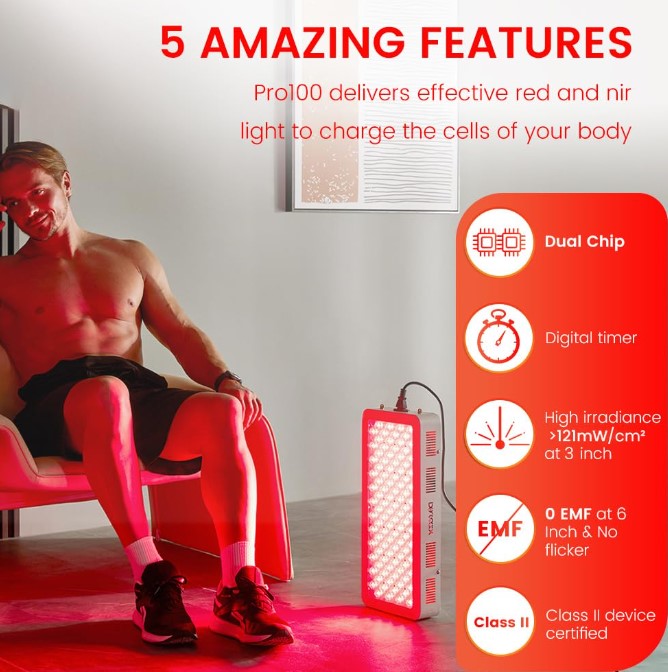BOURSESSENEGAL – Red light therapy has gained attention in recent years for its potential health benefits. This innovative treatment uses specific wavelengths of light to promote healing, reduce inflammation, and rejuvenate the skin. If you’re curious about how red light works and what it can do for you, you’ve come to the right place. In this guide, we’ll dive into everything you need to know about red light , from its science to its applications.
What is Red Light Therapy?
Red light involves exposing your body to low levels of red or near-infrared light. The light penetrates the skin and interacts with cells, leading to various biological effects. This treatment has been explored for various applications, including skin rejuvenation, pain relief, and muscle recovery.
How Does Red Light Therapy Work?
Red light works at the cellular level. When the light penetrates the skin, it stimulates the mitochondria, the powerhouse of cells. This stimulation boosts the production of adenosine triphosphate (ATP), the energy currency of cells. With more energy, cells can repair themselves more efficiently and function optimally.
Furthermore, red light reduces oxidative stress and inflammation, which can accelerate healing processes. Overall, the combination of these effects contributes to the therapy’s potential benefits.
Benefits of Red Light Therapy
Red light offers a range of benefits. Let’s explore some of the most notable ones:
1. Skin Rejuvenation
One of the most popular uses of red light therapy is skin rejuvenation. Studies suggest that it can improve skin tone, reduce wrinkles, and minimize scars. By boosting collagen production, red light helps maintain skin elasticity and firmness.
2. Pain Relief
Red light therapy has shown promise in alleviating pain, particularly chronic pain conditions. Many athletes and individuals with injuries have turned to this therapy for faster recovery and reduced discomfort. The therapy promotes blood flow to the affected areas, facilitating the healing process.
3. Muscle Recovery
For athletes, red light therapy can be a game-changer. It helps reduce muscle soreness and speeds up recovery after intense workouts. By enhancing cellular metabolism, this therapy aids in muscle repair, allowing athletes to return to training sooner.
4. Enhanced Mood and Sleep
Red light therapy may also contribute to improved mood and better sleep quality. Exposure to red light can help regulate melatonin production, the hormone responsible for sleep. This natural regulation can lead to more restful nights and increased energy during the day.
5. Hair Growth
Some studies suggest that red light therapy may stimulate hair growth in individuals experiencing thinning hair or androgenetic alopecia. By enhancing blood circulation in the scalp, it nourishes hair follicles, potentially leading to thicker, healthier hair.
How to Use Red Light Therapy
Now that you understand the benefits, you might be wondering how to incorporate red light therapy into your routine. Here’s a simple guide to get you started.
1. Choose the Right Device
There are various red light devices available, ranging from handheld units to full-body panels. Consider your specific needs and the areas you want to treat when selecting a device.
2. Determine Treatment Duration
Treatment durations can vary based on the device and the condition being treated. Generally, sessions last between 10 to 30 minutes. Start with shorter sessions and gradually increase the duration as your body adjusts.
3. Positioning is Key
Ensure you position the device correctly for optimal results. Maintain the recommended distance between your skin and the device, as this can affect the treatment’s effectiveness.
4. Consistency Matters
For best results, consistency is crucial. Aim for several sessions per week, depending on your goals and the device’s guidelines. Tracking your progress can help you gauge effectiveness over time.
Safety and Side Effects
Red light therapy is generally considered safe for most individuals. However, it’s essential to follow the manufacturer’s instructions to minimize any risks. Some people may experience mild side effects such as temporary redness or irritation. If you have specific medical conditions or concerns, consult with a healthcare professional before starting therapy.
Who Can Benefit from Red Light Therapy?
Many people can benefit from red light therapy. Here are a few groups that may find it particularly useful:
1. Athletes and Fitness Enthusiasts
Athletes looking to enhance recovery and reduce muscle soreness will find red light beneficial. It supports faster healing and helps maintain peak performance.
2. Individuals with Skin Concerns
If you struggle with skin issues such as acne, scars, or wrinkles, red light can be an effective addition to your skincare routine.
3. People with Chronic Pain
Those suffering from chronic pain conditions like arthritis or back pain may experience relief through red light .
4. Individuals Seeking Mood Enhancement
If you’re looking to improve your mood or sleep quality, red therapy can help regulate your body’s natural rhythms.
Conclusion
In summary, red light therapy offers a variety of benefits, from skin rejuvenation to pain relief. As science continues to explore its applications, more individuals are discovering the positive effects of this innovative treatment. Whether you’re an athlete, someone with skin concerns, or simply looking to enhance your overall well-being, red therapy might just be the solution you need.
So, why not give it a try? Embrace the healing power of light and take a step toward a healthier you!
REFERENCE : https://www.cdcfoundation.org/



